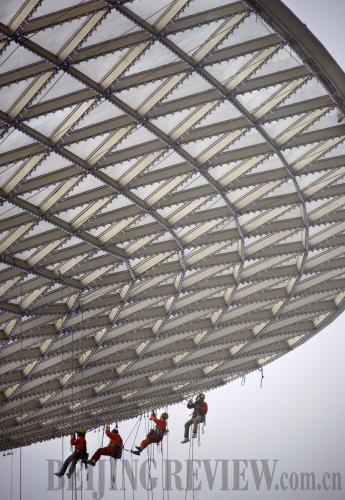|
 |
|
SAVING ENERGY: Workers install LED lights on the horn-shaped Sunny Valleys building in Shanghai on December 4, 2009. Energy-saving equipment has been deployed during the construction of the Shanghai Expo buildings (PEI XIN) |
After Shanghai's success in co-hosting an environmentally friendly Olympics last year with Beijing, China's eastern metropolis is setting another high bar of ecological responsibility for its 2010 World Expo.
As the stage for next year's Expo, the city is preparing to impress with an improved environment and 5.28-square-km garden that features green pavilions.
The Shanghai Municipal Government recently made a promise that air quality over the course of the six-month Expo will be rated as good 95 percent of the time.
Laying a solid foundation
Shanghai, China's economic hub, has been creating three-year action plans since 2000, when it won the right to host the World Expo.
Over the past nine years, the city has invested an average of 3 percent of its gross domestic product annually on environmental projects. The total input has surpassed 225 billion yuan ($32.94 billion).
Shanghai has redeveloped more than 6,000 coal-fired pieces of equipment by harnessing clean energy, creating a 674-square-km coal-free zone. The city has also closed more than 3,000 polluting enterprises.
According to its fourth three-year environmental action plan, Shanghai will build 420 km of rail lines before the Expo's opening and refurbish 7,000 buses and 32,000 taxis by the end of this year.
The city along with the United Nations Environment Program has also released for visitors and residents a green Expo guidebook that advises them on how to be more eco-friendly.
Years of effort and investment have boosted confidence in the ability of city residents and visitors to be able to breathe clean air during the event. City officials, meanwhile, have vowed not to take extreme measures, such as demanding the temporary closure of polluting companies to improve air quality.
"Sulfur dioxide emissions have been controlled very well since heavily polluting factories were removed from the Expo site," said Shu Jiong, a geologist at East China Normal University. Nitrogen dioxide emissions have also been brought in line with national standards, he added.
In recent years, Shanghai has mostly achieved level-two air quality, said Zhang Quan, Director of the Shanghai Environmental Protection Bureau. Level-two air quality, according to China's standard, is slightly less than the level-one quality required at natural reserves and famous natural sightseeing areas.
More efforts, much greener
The Expo's theme is Better City, Better Life, and more than 240 countries and international organizations will come together for six months to explore ways to help cities develop in harmony with nature.
Around 70 million visitors are expected to flock to the event, which opens its doors next May, for a chance to get a glimpse of the most advanced technologies on display in a wide variety of pavilions. Many of advances in the spotlight will highlight environmental issues and sustainable development.
Event organizers have promised that a green theme will tie each pavilion, structure and creative exhibition zone to the Expo garden.
"During construction, energy saving and low consumption and emissions are our priorities," said Zhong Yanqun, Deputy Director of the Expo's Executive Committee. "Advanced technology in environmental protection will be adopted and the city's historical buildings will be well protected."
It has been estimated that the gross capacity of solar power for the Expo garden will reach 4.7 billion kw.
There are six Sun Valleys structures along the Expo Boulevard that links four major venues. The Sun Valleys, made from steel and a special kind of plastic, resemble the open ends of shimmering trumpets and funnel sunlight into underground levels to help save on energy. On December 4, efficient LED lights were installed on the Sun Valleys buildings.
Meanwhile, Shanghai has also taken measures to introduce new vehicles. The Shanghai Automobile Industry Group produced nearly 1,000 new vehicles that incorporate the latest in environmentally friendly technology. The Shanghai Government vowed to support the research and development of vehicles that consume alternative fuels in a ceremony to introduce the group's newest hi-tech vehicles. The total investment will exceed 12 billion yuan ($1.76 billion), according to the government. The vehicles using clean energy will be put into use before next May to help achieve the Expo's goal of zero emissions.
Persuading residents to take buses to work or airline passengers to buy "carbon credits" are among the measures gaining Shanghai much praise as the city aims to shrink its carbon footprint and improve its air quality during the event.
The city is also promoting the use of public transport to counteract the recent boom in private vehicles and gas-guzzling SUVs, according to Hong Hao, Director of the Bureau of Shanghai World Expo Coordination.
As the only city in China that limits the number of license plates through monthly auctions, Shanghai has effectively put a ceiling on private car ownership over the last few years. The hefty—and rising—price of licenses also gives commuters more of an incentive to opt for public transportation.
Meanwhile, new cars registered with Shanghai's vehicle management authority must meet Chinese emission standards, which conform to European levels.
Shanghai started banning high-emission cars from the city's Inner Ring Road area in 2006. The regulation was extended to the Middle Ring Road in August, effectively ridding the downtown area of heavily polluting vehicles.
Long-distance fliers will, meanwhile, be encouraged to buy so-called carbon credits to pay for the planting of new trees to further green the city's industrial belt. | 